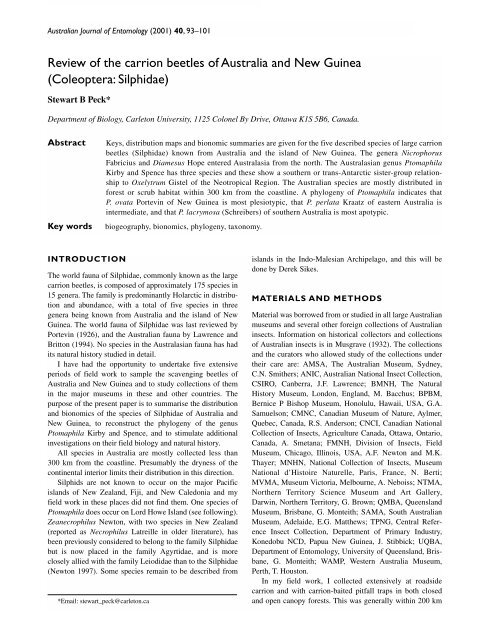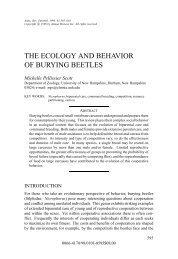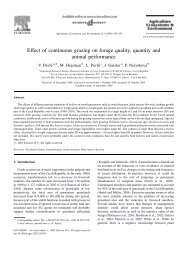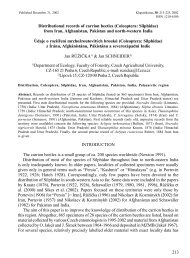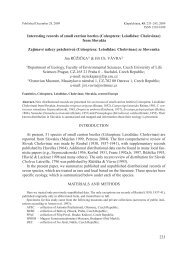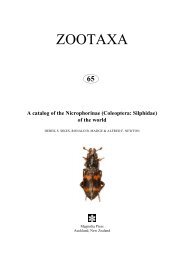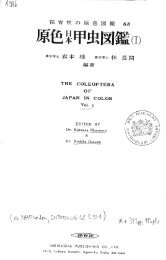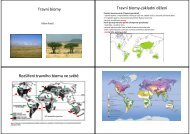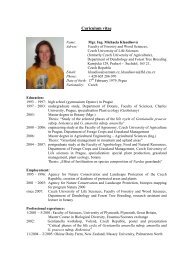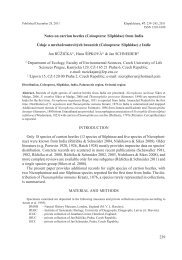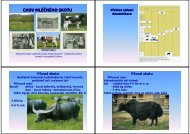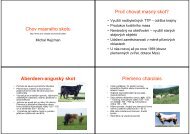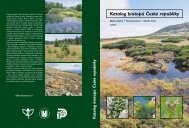Review of the carrion beetles of Australia and New Guinea ...
Review of the carrion beetles of Australia and New Guinea ...
Review of the carrion beetles of Australia and New Guinea ...
You also want an ePaper? Increase the reach of your titles
YUMPU automatically turns print PDFs into web optimized ePapers that Google loves.
<strong>Australia</strong>n Journal <strong>of</strong> Entomology (2001) 40, 93–101<br />
<strong>Review</strong> <strong>of</strong> <strong>the</strong> <strong>carrion</strong> <strong>beetles</strong> <strong>of</strong> <strong>Australia</strong> <strong>and</strong> <strong>New</strong> <strong>Guinea</strong><br />
(Coleoptera: Silphidae)<br />
Stewart B Peck*<br />
Department <strong>of</strong> Biology, Carleton University, 1125 Colonel By Drive, Ottawa K1S 5B6, Canada.<br />
Abstract<br />
Key words<br />
Keys, distribution maps <strong>and</strong> bionomic summaries are given for <strong>the</strong> five described species <strong>of</strong> large <strong>carrion</strong><br />
<strong>beetles</strong> (Silphidae) known from <strong>Australia</strong> <strong>and</strong> <strong>the</strong> isl<strong>and</strong> <strong>of</strong> <strong>New</strong> <strong>Guinea</strong>. The genera Nicrophorus<br />
Fabricius <strong>and</strong> Diamesus Hope entered Australasia from <strong>the</strong> north. The Australasian genus Ptomaphila<br />
Kirby <strong>and</strong> Spence has three species <strong>and</strong> <strong>the</strong>se show a sou<strong>the</strong>rn or trans-Antarctic sister-group relationship<br />
to Oxelytrum Gistel <strong>of</strong> <strong>the</strong> Neotropical Region. The <strong>Australia</strong>n species are mostly distributed in<br />
forest or scrub habitat within 300 km from <strong>the</strong> coastline. A phylogeny <strong>of</strong> Ptomaphila indicates that<br />
P. ovata Portevin <strong>of</strong> <strong>New</strong> <strong>Guinea</strong> is most plesiotypic, that P. perlata Kraatz <strong>of</strong> eastern <strong>Australia</strong> is<br />
intermediate, <strong>and</strong> that P. lacrymosa (Schreibers) <strong>of</strong> sou<strong>the</strong>rn <strong>Australia</strong> is most apotypic.<br />
biogeography, bionomics, phylogeny, taxonomy.<br />
INTRODUCTION<br />
The world fauna <strong>of</strong> Silphidae, commonly known as <strong>the</strong> large<br />
<strong>carrion</strong> <strong>beetles</strong>, is composed <strong>of</strong> approximately 175 species in<br />
15 genera. The family is predominantly Holarctic in distribution<br />
<strong>and</strong> abundance, with a total <strong>of</strong> five species in three<br />
genera being known from <strong>Australia</strong> <strong>and</strong> <strong>the</strong> isl<strong>and</strong> <strong>of</strong> <strong>New</strong><br />
<strong>Guinea</strong>. The world fauna <strong>of</strong> Silphidae was last reviewed by<br />
Portevin (1926), <strong>and</strong> <strong>the</strong> <strong>Australia</strong>n fauna by Lawrence <strong>and</strong><br />
Britton (1994). No species in <strong>the</strong> Australasian fauna has had<br />
its natural history studied in detail.<br />
I have had <strong>the</strong> opportunity to undertake five extensive<br />
periods <strong>of</strong> field work to sample <strong>the</strong> scavenging <strong>beetles</strong> <strong>of</strong><br />
<strong>Australia</strong> <strong>and</strong> <strong>New</strong> <strong>Guinea</strong> <strong>and</strong> to study collections <strong>of</strong> <strong>the</strong>m<br />
in <strong>the</strong> major museums in <strong>the</strong>se <strong>and</strong> o<strong>the</strong>r countries. The<br />
purpose <strong>of</strong> <strong>the</strong> present paper is to summarise <strong>the</strong> distribution<br />
<strong>and</strong> bionomics <strong>of</strong> <strong>the</strong> species <strong>of</strong> Silphidae <strong>of</strong> <strong>Australia</strong> <strong>and</strong><br />
<strong>New</strong> <strong>Guinea</strong>, to reconstruct <strong>the</strong> phylogeny <strong>of</strong> <strong>the</strong> genus<br />
Ptomaphila Kirby <strong>and</strong> Spence, <strong>and</strong> to stimulate additional<br />
investigations on <strong>the</strong>ir field biology <strong>and</strong> natural history.<br />
All species in <strong>Australia</strong> are mostly collected less than<br />
300 km from <strong>the</strong> coastline. Presumably <strong>the</strong> dryness <strong>of</strong> <strong>the</strong><br />
continental interior limits <strong>the</strong>ir distribution in this direction.<br />
Silphids are not known to occur on <strong>the</strong> major Pacific<br />
isl<strong>and</strong>s <strong>of</strong> <strong>New</strong> Zeal<strong>and</strong>, Fiji, <strong>and</strong> <strong>New</strong> Caledonia <strong>and</strong> my<br />
field work in <strong>the</strong>se places did not find <strong>the</strong>m. One species <strong>of</strong><br />
Ptomaphila does occur on Lord Howe Isl<strong>and</strong> (see following).<br />
Zeanecrophilus <strong>New</strong>ton, with two species in <strong>New</strong> Zeal<strong>and</strong><br />
(reported as Necrophilus Latreille in older literature), has<br />
been previously considered to belong to <strong>the</strong> family Silphidae<br />
but is now placed in <strong>the</strong> family Agyrtidae, <strong>and</strong> is more<br />
closely allied with <strong>the</strong> family Leiodidae than to <strong>the</strong> Silphidae<br />
(<strong>New</strong>ton 1997). Some species remain to be described from<br />
*Email: stewart_peck@carleton.ca<br />
isl<strong>and</strong>s in <strong>the</strong> Indo-Malesian Archipelago, <strong>and</strong> this will be<br />
done by Derek Sikes.<br />
MATERIALS AND METHODS<br />
Material was borrowed from or studied in all large <strong>Australia</strong>n<br />
museums <strong>and</strong> several o<strong>the</strong>r foreign collections <strong>of</strong> <strong>Australia</strong>n<br />
insects. Information on historical collectors <strong>and</strong> collections<br />
<strong>of</strong> <strong>Australia</strong>n insects is in Musgrave (1932). The collections<br />
<strong>and</strong> <strong>the</strong> curators who allowed study <strong>of</strong> <strong>the</strong> collections under<br />
<strong>the</strong>ir care are: AMSA, The <strong>Australia</strong>n Museum, Sydney,<br />
C.N. Smi<strong>the</strong>rs; ANIC, <strong>Australia</strong>n National Insect Collection,<br />
CSIRO, Canberra, J.F. Lawrence; BMNH, The Natural<br />
History Museum, London, Engl<strong>and</strong>, M. Bacchus; BPBM,<br />
Bernice P Bishop Museum, Honolulu, Hawaii, USA, G.A.<br />
Samuelson; CMNC, Canadian Museum <strong>of</strong> Nature, Aylmer,<br />
Quebec, Canada, R.S. Anderson; CNCI, Canadian National<br />
Collection <strong>of</strong> Insects, Agriculture Canada, Ottawa, Ontario,<br />
Canada, A. Smetana; FMNH, Division <strong>of</strong> Insects, Field<br />
Museum, Chicago, Illinois, USA, A.F. <strong>New</strong>ton <strong>and</strong> M.K.<br />
Thayer; MNHN, National Collection <strong>of</strong> Insects, Museum<br />
National d’Histoire Naturelle, Paris, France, N. Berti;<br />
MVMA, Museum Victoria, Melbourne, A. Neboiss; NTMA,<br />
Nor<strong>the</strong>rn Territory Science Museum <strong>and</strong> Art Gallery,<br />
Darwin, Nor<strong>the</strong>rn Territory, G. Brown; QMBA, Queensl<strong>and</strong><br />
Museum, Brisbane, G. Monteith; SAMA, South <strong>Australia</strong>n<br />
Museum, Adelaide, E.G. Mat<strong>the</strong>ws; TPNG, Central Reference<br />
Insect Collection, Department <strong>of</strong> Primary Industry,<br />
Konedobu NCD, Papua <strong>New</strong> <strong>Guinea</strong>, J. Stibbick; UQBA,<br />
Department <strong>of</strong> Entomology, University <strong>of</strong> Queensl<strong>and</strong>, Brisbane,<br />
G. Monteith; WAMP, Western <strong>Australia</strong> Museum,<br />
Perth, T. Houston.<br />
In my field work, I collected extensively at roadside<br />
<strong>carrion</strong> <strong>and</strong> with <strong>carrion</strong>-baited pitfall traps in both closed<br />
<strong>and</strong> open canopy forests. This was generally within 200 km
94 SB Peck<br />
<strong>of</strong> <strong>the</strong> eastern coastline from Cooktown, Queensl<strong>and</strong>,<br />
through to Melbourne, Victoria; from Perth to Albany in<br />
Western <strong>Australia</strong>; <strong>and</strong> in <strong>the</strong> Darwin <strong>and</strong> Kakadu National<br />
Park areas <strong>of</strong> <strong>the</strong> Nor<strong>the</strong>rn Territory. Most <strong>of</strong> my specimens<br />
are in CMNC, ANIC, or <strong>the</strong> author’s collection. Additional<br />
material has been contributed to <strong>the</strong> study by: Olga Kukal,<br />
Halifax, Nova Scotia, Canada; A.F. <strong>New</strong>ton <strong>and</strong> Margaret<br />
Thayer, now <strong>of</strong> <strong>the</strong> Field Museum, Chicago, Illinois, USA;<br />
<strong>and</strong> Henry <strong>and</strong> Anne Howden, Ottawa, Ontario, Canada.<br />
Full specimen label data are not reported here but are<br />
available from <strong>the</strong> author. The available label data have been<br />
summarised into generalisations about <strong>the</strong> geographical <strong>and</strong><br />
elevational distribution <strong>of</strong> <strong>the</strong> species, <strong>the</strong> ways <strong>the</strong>y have<br />
been collected, <strong>the</strong> seasonality <strong>of</strong> adult activity, <strong>and</strong> apparent<br />
habitat associations.<br />
A phylogenetic analysis <strong>of</strong> <strong>the</strong> three species <strong>of</strong> Ptomaphila<br />
was by st<strong>and</strong>ard methods <strong>of</strong> outgroup comparison. Data on<br />
characters <strong>of</strong> <strong>the</strong> female genitalia were from direct observation<br />
<strong>and</strong> illustrations in Arnett (1944). The data set was<br />
analysed by MCCLADE 3.1 (Maddison & Maddison 1992).<br />
RESULTS<br />
Key to subfamilies <strong>of</strong> Australasian Silphidae<br />
l Antenna seemingly <strong>of</strong> 10 segments, second antennal<br />
segment small, indistinct, hidden in tip <strong>of</strong> first antennal<br />
segment; epistomal suture present; elytra without<br />
raised longitudinal carinae or tubercles; elytra<br />
usually with irregular red or orange spots, elytra<br />
short, truncate, exposing 3 or 4 abdominal tergites;<br />
fifth abdominal tergite with stridulatory files on<br />
dorsum ............................. Subfamily Nicrophorinae<br />
– Antenna clearly <strong>of</strong> 11 segments, second antennal<br />
segment large, distinct, not hidden in tip <strong>of</strong> first<br />
antennal segment; epistomal suture absent; elytra<br />
with raised longitudinal carinae or tubercules; elytra<br />
with or without coloured areas, elytra long, usually<br />
not truncate (but short <strong>and</strong> exposing 3–4 abdominal<br />
tergites in Diamesus); fifth abdominal tergite lacking<br />
stridulatory files ....................... Subfamily Silphinae<br />
Subfamily Nicrophorinae<br />
The subfamily contains <strong>the</strong> Asian genera Eonecrophorus<br />
Kurosawa <strong>and</strong> Ptomascopus Kraatz, <strong>and</strong> <strong>the</strong> widely distributed<br />
genus Nicrophorus Fabricius. Only Nicrophorus occurs<br />
in <strong>the</strong> Australasian region.<br />
Nicrophorus Fabricius 1775<br />
Nicrophorus, with approximately 82 species worldwide, is<br />
mostly north temperate <strong>and</strong> Holarctic in distribution. One<br />
or more lineages have followed <strong>the</strong> highl<strong>and</strong>s <strong>of</strong> Mexico<br />
<strong>and</strong> Central America southward into <strong>the</strong> Andes Mountains<br />
<strong>of</strong> South America <strong>and</strong> speciated <strong>the</strong>re (Anderson & Peck<br />
1985), <strong>and</strong> one species occurs in <strong>the</strong> mountains <strong>of</strong> Algeria<br />
in Africa. At least one lineage has crossed Wallace’s Line<br />
<strong>and</strong> speciated in <strong>the</strong> isl<strong>and</strong>s <strong>of</strong> <strong>the</strong> Indo-Malesian archipelago<br />
(Table l). Only N. heurni Portevin occurs on <strong>the</strong> large<br />
isl<strong>and</strong> <strong>of</strong> <strong>New</strong> <strong>Guinea</strong> proper, but N. kieticus Mroczowski<br />
occurs on <strong>the</strong> isl<strong>and</strong> <strong>of</strong> Bougainville, which is politically a<br />
part <strong>of</strong> Papua <strong>New</strong> <strong>Guinea</strong>. There are no new data on<br />
<strong>the</strong> latter species. There is no evidence that <strong>the</strong> genus<br />
has ever crossed <strong>the</strong> climatic dry zone bordering Torres<br />
Strait (Walker 1972) from <strong>New</strong> <strong>Guinea</strong> onto <strong>the</strong> <strong>Australia</strong>n<br />
continent.<br />
Nicrophorus heurni Portevin (Figs 2,10)<br />
Nicrophorus heurni Portevin 1926: 211.<br />
Type locality. North-west <strong>New</strong> <strong>Guinea</strong>, Doormanpad Camp,<br />
headwaters <strong>of</strong> <strong>the</strong> Mamberamo River, 1410 m elevation.<br />
Type specimen seen; in MNHN. Paratypes are in Berlin <strong>and</strong><br />
MNHN.<br />
Distribution. Upl<strong>and</strong> forests <strong>of</strong> <strong>the</strong> isl<strong>and</strong> <strong>of</strong> <strong>New</strong> <strong>Guinea</strong>, in<br />
both Irian Jaya <strong>and</strong> Papua <strong>New</strong> <strong>Guinea</strong> halves (Fig. 10).<br />
Bionomics. I have seen 206 specimens. Their label data indicate<br />
that adults have been collected at elevations from 480 m<br />
to 2750 m. Collections are from all months <strong>of</strong> <strong>the</strong> year <strong>and</strong><br />
are from <strong>carrion</strong> or human-dung baited pitfall traps or from<br />
mercury-vapour <strong>and</strong> ultraviolet light traps. Habitat data are<br />
few but all collections seem to come from lower <strong>and</strong> upper<br />
elevation montane rainforest.<br />
Table 1<br />
List <strong>of</strong> Indo-Malesian species <strong>of</strong> Nicrophorus*<br />
Species<br />
Distribution<br />
N. nepalensis Hope 1831 South-east Asia, Indonesia (Sumatra, Java, Borneo, Flores), nor<strong>the</strong>rn Philippines (Luzon, Palawan) (Mroczkowski 1966)<br />
N. distinctus Grouvelle 1885 Indonesia: Sulawesi; lowl<strong>and</strong> localities<br />
N. insularis Grouvelle 1893 Indonesia: Java, Sumatra<br />
N. podagricus Portevin 1920 Indonesia: Borneo, Celebes<br />
N. heurni Portevin 1926 <strong>New</strong> <strong>Guinea</strong><br />
N. benguetensis Arnett 1946 Philippines: Luzon<br />
N. apo Arnett 1950 Philippines: Mindanao<br />
N. kieticus Mroczowski 1959 Papua <strong>New</strong> <strong>Guinea</strong>: Bougainville Isl<strong>and</strong>; lowl<strong>and</strong> localities<br />
N. sp. n. Indonesia: Flores<br />
N. sp. n. Indonesia: Sumatra<br />
N. sp. n. Indonesia: Sulawesi; highl<strong>and</strong> localities<br />
N. sp. n. Solomon Isl<strong>and</strong>s; highl<strong>and</strong> localities<br />
*For undescribed species see Hanski <strong>and</strong> Krikken 1991 <strong>and</strong> Hanski & Niemelä 1990.
Australasian <strong>carrion</strong> <strong>beetles</strong> 95<br />
Subfamily Silphinae<br />
Key to tribes <strong>of</strong> Australasian Silphinae<br />
l Pronotum coarsely punctate, lateral margins not flattened,<br />
not <strong>of</strong> lighter colour; elytra short, truncate,<br />
normally 3 or 4 abdominal segments exposed; with<br />
one raised outer costa <strong>and</strong> two flat inner costae;<br />
hindfemora robust, <strong>of</strong>ten greatly exp<strong>and</strong>ed ...............<br />
..........................................................Tribe Necrodini<br />
– Pronotum finely punctate, lateral margins flattened<br />
<strong>and</strong> <strong>of</strong> lighter colour; elytra long, normally covering<br />
all but last abdominal segment; elytral costae broken<br />
into a series <strong>of</strong> three rows <strong>of</strong> tubercules or pustules;<br />
hindfemora thin, not exp<strong>and</strong>ed ........... Tribe Silphini<br />
Tribe Necrodini<br />
Diamesus Hope 1840<br />
The genus contains only two species, D. bimaculatus<br />
Portevin <strong>of</strong> Taiwan <strong>and</strong> <strong>the</strong> following species.<br />
Diamesus osculans (Vigors) (Figs 1,11)<br />
Silpha osculans Vigors 1825: 537.<br />
Type locality. ‘India Orientali’, type specimen seen, in<br />
BMNH, with printed label ‘Madras Major Sale’.<br />
Distribution. The species is distributed from Sri Lanka <strong>and</strong><br />
sou<strong>the</strong>rn India to Vietnam <strong>and</strong> through Malaysia, Thail<strong>and</strong>,<br />
Sumatra, Java, Borneo, <strong>the</strong> Philippines <strong>and</strong> <strong>New</strong> Britain<br />
(Arnett 1950; Mroczkowski 1966). It is widely distributed in<br />
<strong>New</strong> <strong>Guinea</strong> <strong>and</strong> in <strong>Australia</strong> from north-eastern Western<br />
<strong>Australia</strong>, eastward along <strong>the</strong> north coast <strong>and</strong> down <strong>the</strong> east<br />
coast to sou<strong>the</strong>rn <strong>New</strong> South Wales (Fig. 11). It seems<br />
strange that Portevin (1926) gave no <strong>Australia</strong>n records for<br />
<strong>the</strong> species because MNHN has eastern <strong>Australia</strong> specimens<br />
collected by von Mueller in 1896 (unnamed locality) <strong>and</strong> in<br />
1917 in Normanton, Queensl<strong>and</strong>.<br />
The seeming absence <strong>of</strong> early records may be <strong>the</strong> reason<br />
that Tillyard (1926) stated that <strong>the</strong> species was introduced<br />
into nor<strong>the</strong>rn Queensl<strong>and</strong>, but he gives no details or evidence.<br />
It seems unlikely that <strong>the</strong> species was introduced by<br />
human action, but it also seems strange that <strong>the</strong>re are no<br />
records <strong>of</strong> this large beetle from <strong>the</strong> early or mid 1800s. Most<br />
<strong>Australia</strong>n records date from 1950 <strong>and</strong> later but <strong>the</strong>re is<br />
ano<strong>the</strong>r record from Cairns in 1909 <strong>and</strong> Sydney in 1925. The<br />
tolerance <strong>of</strong> <strong>the</strong> species for open habitats suggests that it<br />
could have easily crossed <strong>the</strong> continental-shelf l<strong>and</strong>-bridge<br />
<strong>of</strong> <strong>the</strong> Torres Straits from <strong>New</strong> <strong>Guinea</strong> to Queensl<strong>and</strong> at<br />
times <strong>of</strong> low sea levels in <strong>the</strong> Pleistocene (Walker 1972).<br />
Bionomics. I have seen 412 specimens from <strong>New</strong> <strong>Guinea</strong><br />
<strong>and</strong> 135 from <strong>Australia</strong>. The species has been collected from<br />
sea level to 1500 m in <strong>New</strong> <strong>Guinea</strong> in every month <strong>of</strong> <strong>the</strong><br />
year. Some collections are from <strong>carrion</strong> but most are from<br />
mercury-vapor lights or black-light traps. Habitats are mostly<br />
rainforest but some collections are from disturbed or secondary<br />
open <strong>and</strong> closed canopy forest sites. In <strong>Australia</strong> collections<br />
are from sea level up to 250 m. Specimens have been<br />
taken in every month except September <strong>and</strong> October <strong>and</strong> all<br />
are from <strong>carrion</strong> or <strong>carrion</strong> baits or ultraviolet or mercuryvapor<br />
light traps. Habitats are pastures, open sclerophyll<br />
forest, wet sclerophyll forest, <strong>and</strong> rainforest. Williams (1981)<br />
presents records from <strong>New</strong> South Wales <strong>and</strong> notes that adults<br />
make a high pitched sound in flight.<br />
Tribe Silphini<br />
Genus Ptomaphila Kirby <strong>and</strong> Spence 1828<br />
The genus is known only from <strong>Australia</strong> <strong>and</strong> <strong>New</strong> <strong>Guinea</strong><br />
<strong>and</strong> contains three species. It is most closely related to Oxelytrum<br />
Gistel <strong>of</strong> <strong>the</strong> Neotropics, with which it shares such<br />
apomorphic characters as a costate elytron, a longitudinally<br />
striate swelling on <strong>the</strong> intersegmental membranes between<br />
abdominal tergites 7 <strong>and</strong> 8 (possibly a stridulatory structure),<br />
<strong>and</strong> long hairs near <strong>the</strong> apical callus on <strong>the</strong> elytral underside<br />
Figs 1–7. Habitus photographs <strong>of</strong> species <strong>of</strong> Silphidae occurring in <strong>Australia</strong> <strong>and</strong> <strong>New</strong> <strong>Guinea</strong>: (1) Diamesus osculans;<br />
(2) Nicrophorus heurni; (3) Ptomaphila ovata; (4) female Ptomaphila perlata; (5) male Ptomaphila perlata; (6) female Ptomaphila<br />
lacrymosa; (7) male Ptomaphila lacrymosa. Bar =10 mm.
96 SB Peck<br />
(Anderson & Peck 1985). The genus is characterised by <strong>the</strong><br />
apomorphic characters <strong>of</strong> <strong>the</strong> elytral apex bearing a flange,<br />
<strong>the</strong> head lacking a frontal chevron, a tuberculate elytron <strong>and</strong><br />
an extremely wide elytral epipleuron (Anderson & Peck<br />
1985).<br />
Key to species <strong>of</strong> Ptomaphila<br />
1 Last three antennal segments not <strong>of</strong> <strong>the</strong> same colour,<br />
basal two segments greyish or blackish, terminal<br />
segment yellow-orange; <strong>New</strong> <strong>Guinea</strong> ........................<br />
............................................................ ovata Portevin<br />
– Last three antennal segments <strong>of</strong> <strong>the</strong> same yellow–<br />
orange colour; <strong>Australia</strong> ......................................... 2<br />
2 Elytral carinal tubercules more prominent, higher,<br />
broader (Fig. 8); elytral lateral margins lighter in<br />
colour than elytral disc, yellow–orange in colour;<br />
occipital carina entire .......... lacrymosa (Schreibers)<br />
– Elytral carinal tubercules less distinct, lower,<br />
narrow-elongate (Fig. 9); elytral lateral margins not<br />
lighter in colour than elytral disc; occipital carina<br />
emarginate in middle ......................... perlata Kraatz<br />
Ptomaphila ovata Portevin (Figs 3,12,16)<br />
Ptomaphila ovata Portevin 1926: 210.<br />
Type locality. North-western <strong>New</strong> <strong>Guinea</strong>, headwaters <strong>of</strong> <strong>the</strong><br />
Mamberamo River, Doormanpad Camp, 1410 m elevation.<br />
Type specimen seen, in MNHN. Paratypes are in Berlin <strong>and</strong><br />
MNHN.<br />
Distribution. Known only from Irian Jaya <strong>and</strong> Papua <strong>New</strong><br />
<strong>Guinea</strong> (Fig. 12).<br />
Bionomics. I have seen 66 specimens. Adults have been collected<br />
from 1400 m to 2850 m elevation <strong>and</strong> in every month<br />
<strong>of</strong> <strong>the</strong> year except February to April. The collections come<br />
from <strong>carrion</strong> <strong>and</strong> human-dung baited pitfall traps or mercuryvapor<br />
<strong>and</strong> ultraviolet light traps. The habitats are all upper<br />
elevation montane rainforest.<br />
Ptomaphila perlata Kraatz (Figs 4,5,9,13,17)<br />
Ptomaphila perlata Kraatz 1876: 356.<br />
Type locality. Not given. Type specimen not seen, in Institut<br />
für Pflanzenschatzforschung, Eberswalde, Germany.<br />
Distribution. The species occurs in eastern <strong>Australia</strong> from<br />
Gippsl<strong>and</strong>, Victoria, north to <strong>the</strong> Lockerbie Scrub <strong>of</strong> Cape<br />
York Peninsula, Queensl<strong>and</strong> (Fig. 13). There is also a population<br />
on Lord Howe Isl<strong>and</strong>. The earliest records from Lord<br />
Howe Isl<strong>and</strong> are from 1962 <strong>and</strong> 1966 (in AMSA). I found it<br />
on Lord Howe Isl<strong>and</strong> in abundance in 1980 following a<br />
National Park conservation campaign that shot many feral<br />
pigs <strong>and</strong> left <strong>the</strong>ir bodies in <strong>the</strong> forests. It seems unlikely that<br />
Figs 8,9. Left elytra <strong>of</strong> Ptomaphila<br />
spp.: (8) P. lacrymosa; (9)<br />
P. perlata. Bar = 5 mm.
Australasian <strong>carrion</strong> <strong>beetles</strong> 97<br />
humans would ei<strong>the</strong>r intentionally or accidentally introduce<br />
this insect to <strong>the</strong> isl<strong>and</strong>, so it presumably was a natural<br />
colonisation.<br />
Bionomics. I have seen 371 specimens. The species is apparently<br />
less abundant than P. lacrymosa. Adults have been collected<br />
from sea level up to 1560 m elevation at <strong>the</strong> summit <strong>of</strong><br />
Mt Bellenden Ker in Queensl<strong>and</strong>. They have been taken in<br />
all months <strong>of</strong> <strong>the</strong> year except March. All collections are from<br />
<strong>carrion</strong> baits or <strong>carrion</strong> such as pigs <strong>and</strong> rats or at lights. They<br />
occur in rainforests, temperate rainforests, <strong>and</strong> wet sclerophyll<br />
forests.<br />
Ptomaphila lacrymosa (Schreibers)<br />
(Figs 6,7,8,14,18)<br />
Silpha lacrymosa Schreibers 1802: 194.<br />
Type locality. ‘Nova Holl<strong>and</strong>ia.’ Type specimen not seen, in<br />
Naturhistorisches Museum Wien, Vienna, Austria. <strong>New</strong><br />
Holl<strong>and</strong> was a vague term generally applied in <strong>the</strong> late 1700s<br />
to <strong>the</strong> whole continent <strong>of</strong> <strong>Australia</strong>. The specimens were<br />
collected by John Francillon, a British doctor, probably in<br />
south-eastern <strong>New</strong> South Wales <strong>and</strong> in <strong>the</strong> vicinity <strong>of</strong><br />
Sydney. Some parts <strong>of</strong> his collection are now in BMNH <strong>and</strong><br />
<strong>the</strong> Oxford Museum.<br />
Distribution. The species occurs in <strong>the</strong> sou<strong>the</strong>rn half <strong>of</strong> <strong>Australia</strong>.<br />
In <strong>the</strong> east it ranges from south-eastern Queensl<strong>and</strong>,<br />
through <strong>New</strong> South Wales <strong>and</strong> Victoria, <strong>and</strong> west to <strong>the</strong> Eyre<br />
Peninsula <strong>of</strong> South <strong>Australia</strong> <strong>and</strong> throughout Tasmania.<br />
There is an apparent range disjunction across <strong>the</strong> Nullarbor<br />
Plain. In Western <strong>Australia</strong>, it ranges from near Esperance<br />
<strong>the</strong>n west <strong>and</strong> north to near Northampton (Fig. 14).<br />
Bionomics. I have seen 640 specimens. Adults have been<br />
collected from sea level to 1330 m on Mt Buffalo, Victoria.<br />
They have been taken in all months <strong>of</strong> <strong>the</strong> year. Most collections<br />
are from <strong>carrion</strong> baits or <strong>carrion</strong>, including dead sea<br />
birds, or at lights <strong>and</strong> light traps. Adults have been observed<br />
to feed on maggots on vertebrate carcasses. They occur in a<br />
variety <strong>of</strong> habitats including Noth<strong>of</strong>agus forests, temperate<br />
rainforests, wet sclerophyll forest, open Eucalyptus woodl<strong>and</strong><br />
<strong>and</strong> coastal heath.<br />
DISCUSSION<br />
Phylogeny <strong>of</strong> Ptomaphila<br />
Oxelytrum is <strong>the</strong> likely sister group <strong>of</strong> Ptomaphila (Anderson<br />
& Peck 1985) <strong>and</strong> this is used as an outgroup for phylogenetic<br />
interpretation <strong>of</strong> characters. No informative characters<br />
were found on <strong>the</strong> male aedeagus <strong>of</strong> ei<strong>the</strong>r genus.<br />
Several characters <strong>of</strong> <strong>the</strong> female genitalia were found to be<br />
informative, as well as various external structures. Female<br />
genitalia have been used previously in a study <strong>of</strong> silphids<br />
only by Arnett (1944). Female genitalia <strong>of</strong> Ptomaphila were<br />
compared with Oxelytrum cayennense (Stürm) (Fig. 15) <strong>and</strong><br />
Figs 10,11. Distributions <strong>of</strong><br />
Australasian Silphidae: (10)<br />
Nicrophorus heurni; (11) Diamesus<br />
osculans.
98 SB Peck<br />
Figs 12–14.<br />
Distributions <strong>of</strong> Australasian Silphidae: (12) Ptomaphila ovata; (13) Ptomaphila perlata; (14) Ptomaphila lacrymosa.<br />
Table 2<br />
Analysis <strong>of</strong> character transformations in <strong>the</strong> species <strong>of</strong> Ptomaphila*<br />
Character O. cayennense; outgroup P. ovata P. perlata P. lacrymosa<br />
1. Frontal chevron Present, 1 Absent, 0 Absent, 0 Absent, 0<br />
2. Occipital carina Entire, 0 Emarginate, 1 Emarginate, 1 Emarginate, 1<br />
3. Antennal club segments All dark, 0 XI yellowish, 1 IX–XI yellowish, 2 IX–XI yellowish, 2<br />
4. Pronotum hind-angles Obtuse, 0 Rounded, 1 Rounded, 1 Rounded, 1<br />
5. Pronotum costae elevated Present, 0 Absent, 1 Absent, 1 Absent, 1<br />
6. Elytral carinae Tricostate, 0 Tuberculate, 1 Tuberculate, 1 Tuberculate, 1<br />
7. Elytral epipleuron Narrow, 0 Wide, 1 Wide, 1 Wide, 1<br />
8. Apical elytral undersurface hairs Present, 1 Absent, 0 Absent, 0 Absent, 0<br />
9. Elytral tip colour Dark, 0 Yellowish, 1 Dark, 0 Dark, 0<br />
10. Elytral apical flange Absent, 0 Present, 1 Present, 1 Present,1<br />
11. Colour <strong>of</strong> elytral sides, Dark as disc, 0 Dark as disc, 0 Dark as disc, 0 Lighter than disc, 1<br />
12. Male hind-coxae With tubercles, 1 Without tubercles, 0 Without tubercles, 0 Without tubercles, 0<br />
13. Elytral surface Coarsely punctate, 1 Finely punctate, 0 Finely punctate, 0 Finely punctate, 0<br />
14. Female tergum 10 setae Long, 1 Short, 0 Long, 1 Long, 1<br />
15. Female tergum 9 setae Present, 0 Absent, 1 Present, 0 Absent, 1<br />
16. Female gonocoxite l setae Lateral, 0 Lateral, 0 Lateral, 0 Inner, 1<br />
17. Gonocoxite 2 shape Elongate, 0 Elongate, 0 Shorter, 1 Scoop shaped, 2<br />
18. Gonocoxite 2 sclerotisation Thin, 0 Thin, 0 Thin, 0 Thickened, fossorial, 1<br />
19. Female gonostylus shape Elongate, 0 Elongate, 0 Shorter, 1 Much reduced, 2<br />
20. Gonostylus setae Long, 0 Long, 0 Long, 0 Short, 1<br />
21. Gonostylus position Terminal, 0 Terminal, 0 Terminal, 0 Lateral, 1<br />
*Oxelytrum cayennense was used as an outgroup. Character transformations: 0, plesiotypic; 1 <strong>and</strong> 2 apotypic.
Australasian <strong>carrion</strong> <strong>beetles</strong> 99<br />
Figs 15–18. Female genitalia <strong>of</strong> Oxelytrum <strong>and</strong> Ptomaphila: (15) O. cayennense; (16) P. ovata; (17) P. perlata; (18) P. lacrymosa.<br />
TIX, tergum 9; TX, tergum 10; G1, gonocoxite 1; G2, gonocoxite 2; S, stylus. Bar = 1 mm.<br />
Fig. 19. Maximum parsimony cladogram <strong>of</strong> phylogenetic relationships <strong>of</strong> Australasian species <strong>of</strong> Ptomaphila. Data from Table 2.<br />
Outgroup representative: Oxelytrum cayennense. Geographical areas: Neo, Neotropical; NG, <strong>New</strong> <strong>Guinea</strong>; EA, eastern <strong>Australia</strong>; SA,<br />
sou<strong>the</strong>rn <strong>Australia</strong>.
100 SB Peck<br />
O. discicolle (Brulé) (in Arnett 1944; Fig. 5). Informative<br />
characters <strong>and</strong> hypo<strong>the</strong>ses <strong>of</strong> character transformations are<br />
presented in Table 2. Characters 3, 15, 17, <strong>and</strong> 19 are <strong>the</strong><br />
only shared derived states that are nei<strong>the</strong>r unistate nor<br />
autapomorphic. The maximum parsimony phylogenetic relationships<br />
<strong>of</strong> <strong>the</strong> species are shown in Fig. 19.<br />
Ptomaphila ovata is <strong>the</strong> most plesiomorphic. Ptomaphila<br />
perlata <strong>and</strong> P. lacrymosa are sister species. Ptomaphila<br />
lacrymosa is <strong>the</strong> most derived, especially in characters <strong>of</strong> <strong>the</strong><br />
female genitalia, which are highly modified for digging<br />
during oviposition.<br />
Zoogeography <strong>of</strong> Australasian Silphidae<br />
The fauna is composed <strong>of</strong> two components. The first probably<br />
entered Australasia from <strong>the</strong> north <strong>and</strong> in fairly recent<br />
times sometime after <strong>the</strong> nor<strong>the</strong>rn edge <strong>of</strong> <strong>the</strong> <strong>Australia</strong>n<br />
Plate joined <strong>the</strong> sou<strong>the</strong>rn margin <strong>of</strong> <strong>the</strong> Asian Plate.<br />
Nicrophorus <strong>and</strong> Diamesus <strong>the</strong>n followed <strong>the</strong> Indo-Malesian<br />
isl<strong>and</strong> chain across Wallace’s line into Australasia. Nicrophorus<br />
has speciated in <strong>the</strong> upl<strong>and</strong>s <strong>of</strong> several isl<strong>and</strong>s along<br />
<strong>the</strong> chain (Table 1).<br />
The second is an ancient Gondwanal<strong>and</strong> component. The<br />
ancestor <strong>of</strong> Ptomaphila probably became separated from that<br />
<strong>of</strong> Oxelytron at <strong>the</strong> time <strong>of</strong> <strong>the</strong> separation <strong>of</strong> Gondwanal<strong>and</strong><br />
when <strong>the</strong> <strong>Australia</strong>n Plate separated from <strong>the</strong> South American<br />
Plate. Ptomaphila ovata <strong>of</strong> <strong>New</strong> <strong>Guinea</strong> seems least<br />
changed from <strong>the</strong> ancestral condition. The more derived<br />
sister pair <strong>of</strong> P. lacrymosa <strong>and</strong> P. perlata probably speciated<br />
in <strong>Australia</strong>, but <strong>the</strong> extrinsic isolating mechanism that<br />
helped to separate <strong>the</strong>m is not obvious. The digging modifications<br />
<strong>of</strong> <strong>the</strong> ovipositor <strong>of</strong> P. lacrymosa may have helped it<br />
to colonise <strong>the</strong> more temperate climates <strong>of</strong> sou<strong>the</strong>rn <strong>Australia</strong>.<br />
The range disjunction <strong>of</strong> P. lacrymosa across <strong>the</strong><br />
Nullarbor Plain is a frequent biogeographic pattern <strong>and</strong> is<br />
usually related to Pleistocene aridity severing <strong>the</strong> once, more<br />
continuous forest corridor across <strong>the</strong> sou<strong>the</strong>rn margin <strong>of</strong> <strong>the</strong><br />
continent.<br />
Prospects<br />
Opportunities remain for <strong>the</strong> detailed study <strong>of</strong> ecology <strong>and</strong><br />
natural history <strong>of</strong> all <strong>Australia</strong>n species <strong>of</strong> Silphidae. Field<br />
studies could be modelled after those <strong>of</strong> Anderson (1982),<br />
Beninger <strong>and</strong> Peck (1992), Ratcliffe (1972) or Sikes (1996)<br />
on species in <strong>the</strong> Nearctic fauna. Where <strong>the</strong> ranges <strong>of</strong> <strong>the</strong><br />
<strong>Australia</strong>n species overlap, all species may occur in <strong>the</strong> same<br />
local habitat. If <strong>the</strong>y divide resources through elevation,<br />
habitat preferences or have some seasonal partitioning <strong>of</strong><br />
activity, as found in o<strong>the</strong>r silphids, remains to be learned<br />
(Anderson 1982; Hanski & Niemelä 1990). The larvae <strong>of</strong> all<br />
species remain undescribed.<br />
ACKNOWLEDGEMENTS<br />
I thank all curators for allowing study <strong>of</strong> collections in <strong>the</strong>ir<br />
care <strong>and</strong> especially all collectors (too numerous to mention<br />
individually) who contributed to <strong>the</strong>se collections. Martin<br />
Brendel provided additional data on specimens in BMNH.<br />
The Directors <strong>of</strong> National Parks in <strong>New</strong> South Wales,<br />
Queensl<strong>and</strong>, Victoria, Western <strong>Australia</strong> <strong>and</strong> Nor<strong>the</strong>rn Territory<br />
issued permits for study <strong>of</strong> <strong>the</strong> beetle faunas in <strong>the</strong> many<br />
sites under <strong>the</strong>ir protection. CSIRO, Dr J. Ridsdill-Smith,<br />
<strong>and</strong> especially Dr J.F. Lawrence provided many facilities<br />
without which I would not have been able to undertake <strong>the</strong><br />
fieldwork. The <strong>Australia</strong>n Biological Resources Study<br />
(ABRS) contributed a grant in support <strong>of</strong> field work. Dr<br />
Ge<strong>of</strong>f Monteith <strong>and</strong> <strong>the</strong> Queensl<strong>and</strong> Museum provided much<br />
aid <strong>and</strong> advice for 3 months <strong>of</strong> field work in Queensl<strong>and</strong>.<br />
Jarmila Kukalova-Peck helped with all <strong>the</strong> field work. Joyce<br />
Cook helped with technical matters. Dr H.F. Howden<br />
reviewed <strong>the</strong> manuscript. Derek Sikes, Ronald B. Madge <strong>and</strong><br />
Alfred F. <strong>New</strong>ton, Jr generously shared data <strong>and</strong> ideas on<br />
silphid species <strong>and</strong> characters. The Natural Sciences <strong>and</strong><br />
Engineering Research Council <strong>of</strong> Canada provided partial<br />
funding for a total <strong>of</strong> 11 months <strong>of</strong> field work in <strong>Australia</strong><br />
<strong>and</strong> for 1 month in Papua <strong>New</strong> <strong>Guinea</strong>.<br />
REFERENCES<br />
Anderson RS. 1982. Resource partitioning in <strong>the</strong> <strong>carrion</strong> beetle (Coleoptera:<br />
Silphidae) fauna <strong>of</strong> sou<strong>the</strong>rn Ontario; Ecological <strong>and</strong> evolutionary<br />
considerations. Canadian Journal <strong>of</strong> Zoology 60, 1314–1325.<br />
Anderson RS & Peck SB. 1985. Taxonomy, phylogeny <strong>and</strong> biogeography<br />
<strong>of</strong> <strong>the</strong> <strong>carrion</strong> <strong>beetles</strong> <strong>of</strong> Latin America (Coleoptera: Silphidae).<br />
Quaestiones Entomologicae 21, 247–317.<br />
Arnett RH Jr. 1944. A revision <strong>of</strong> <strong>the</strong> Nearctic Silphini <strong>and</strong> Nicrophorini<br />
based upon female genitalia (Coleoptera, Silphidae). Journal <strong>of</strong> <strong>the</strong><br />
<strong>New</strong> York Entomological Society 52, 1–25.<br />
Arnett RH Jr. 1950. The Silphidae <strong>of</strong> <strong>the</strong> Philippine Isl<strong>and</strong>s<br />
(Coleoptera). Proceedings <strong>of</strong> <strong>the</strong> Entomological Society <strong>of</strong> Washington<br />
52, 63–69.<br />
Beninger CW & Peck SB. 1992. Temporal <strong>and</strong> spatial patterns <strong>of</strong><br />
resource use among Nicrophorus <strong>carrion</strong> <strong>beetles</strong> (Coleoptera:<br />
Silphidae) in a sphagnum bog <strong>and</strong> adjacent forest near Ottawa,<br />
Canada. Canadian Entomologist 124, 79–86.<br />
Hanski I & Krikken J. 1991. Dung <strong>beetles</strong> in tropical forests <strong>of</strong> sou<strong>the</strong>ast<br />
Asia. In: Dung Beetle Ecology (eds I Hanski & Y Camberfort)<br />
pp. 179–197. Princeton University Press, Princeton, NJ.<br />
Hanski I & Niemelä J. 1990. Elevational distributions <strong>of</strong> dung <strong>and</strong><br />
<strong>carrion</strong> <strong>beetles</strong> in nor<strong>the</strong>rn Sulawesi. In: Insects <strong>and</strong> <strong>the</strong> Rainforests<br />
<strong>of</strong> South East Asia (Wallacea) (eds WJ Knight & JD Holloway)<br />
pp. 145–152. Royal Entomological Society, London.<br />
Kraatz G. 1876. Ueber systematik und geographische Verbreitung der<br />
Gattung Silpha und verw<strong>and</strong>te Genera. Deutsche Entomologische<br />
Zeitschrift 20, 353–374.<br />
Lawrence JF & Britton EB. 1994. <strong>Australia</strong>n Beetles. Melbourne University<br />
Press, Melbourne, <strong>Australia</strong>.<br />
Maddison WP & Maddison DR. 1992. MacClade: Analysis <strong>of</strong> Phylogeny<br />
<strong>and</strong> Character Evolution, Version 3. Sinauer Associates,<br />
Sunderl<strong>and</strong>, Massachusetts.<br />
Mroczkowski M. 1966. Silphidae, Catopidae <strong>and</strong> Dermestidae <strong>of</strong> <strong>the</strong><br />
Noona Dan Expedition to <strong>the</strong> Philippine <strong>and</strong> Bismarck Isl<strong>and</strong>s.<br />
Entomologiske Meddelelser 34, 325–328.<br />
Musgrave A. 1932. Bibliography <strong>of</strong> <strong>Australia</strong>n Entomology 1775–1930.<br />
Royal Zoological Society <strong>of</strong> <strong>New</strong> South Wales, Sydney.<br />
<strong>New</strong>ton AF. 1997. <strong>Review</strong> <strong>of</strong> Agyrtidae (Coleoptera), with a new genus<br />
<strong>and</strong> species from <strong>New</strong> Zeal<strong>and</strong>. Annales Zoologici (Warszawa) 47,<br />
111–156.<br />
Portevin G. 1926. Description de deux silphides nouveaux de Nouvelle<br />
Guinée. Nova <strong>Guinea</strong> 15, 210–211.<br />
Ratcliffe BC. 1972. The natural history <strong>of</strong> Necrodes surinamensis.<br />
Transactions <strong>of</strong> <strong>the</strong> American Entomological Society 98, 359–410.
Australasian <strong>carrion</strong> <strong>beetles</strong> 101<br />
Schreibers CFA. 1802. Descriptions <strong>of</strong> some singular coleopterous<br />
insects. Transactions <strong>of</strong> <strong>the</strong> Linnean Society <strong>of</strong> London 6, 185–206.<br />
Sikes DS. 1996. The natural history <strong>of</strong> Nicrophorus nigrita, a western<br />
Nearctic species (Coleoptera: Silphidae). Pan-Pacific Entomologist 72,<br />
70–81.<br />
Tillyard RJ. 1926. The Insects <strong>of</strong> <strong>Australia</strong> <strong>and</strong> <strong>New</strong> Zeal<strong>and</strong>. Angus <strong>and</strong><br />
Robertson, Sydney.<br />
Vigors NA. 1825. Descriptions <strong>of</strong> some rare, interesting, or hi<strong>the</strong>rto<br />
uncharacterized subjects <strong>of</strong> zoology. Zoological Journal 1,<br />
409–418, 526–542.<br />
Walker D, ed. 1972. Bridge <strong>and</strong> Barrier: The Natural <strong>and</strong> Cultural<br />
History <strong>of</strong> Torres Strait, Publication BG/3. Department <strong>of</strong> Biogeography<br />
<strong>and</strong> Geomorphology, Research School <strong>of</strong> Pacific Studies,<br />
<strong>Australia</strong>n National University, Canberra.<br />
Williams G. 1981. Records <strong>of</strong> <strong>the</strong> <strong>carrion</strong> beetle Diamesus osculans<br />
Vigors (Silphidae: Coleoptera) from <strong>New</strong> South Wales. <strong>Australia</strong>n<br />
Entomological Magazine 8, 47.<br />
Accepted for publication 21 November 2000.


